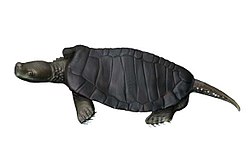| Kayenta Formation | |
|---|---|
| Stratigraphic range: Sinemurian-Toarcian ~ | |
 Kayenta Formation, Capitol Reef National Park, Utah. | |
| Type | Geological formation |
| Unit of | Glen Canyon Group |
| Underlies | Navajo Sandstone |
| Overlies | Wingate Sandstone |
| Thickness | 100 to 120 metres (330 to 390 ft) |
| Lithology | |
| Primary | Sandstone |
| Other | Siltstone, Limestone |
| Location | |
| Coordinates | 37°48′N110°36′W / 37.8°N 110.6°W |
| Country | United States |
| Extent | northern Arizona, northwest Colorado, Nevada, and Utah [1] |
| Type section | |
| Named for | Kayenta, Arizona |

The Kayenta Formation is a geological formation in the Glen Canyon Group that is spread across the Colorado Plateau area of the United States, including northern Arizona, northwest Colorado, Nevada, and Utah. Originally suggested as being Sinemurian-Pliensbachian, but more recent dating of detrital zircons has yielded a depositional age of 183.7 ± 2.7 Ma, thus a Pliensbachian-Toarcian age is more likely. [2] A previous depth work recovered a solid "Carixian" (Lower-Middle Pliensbachian) age from measurements done in the Tenney Canyon. [3] More recent works have provided varied datations for the layers, with samples from Colorado and Arizona suggesting 197.0±1.5-195.2±5.5 Ma (Middle Sinemurian), while the topmost section is likely Toarcian or close in age, maybe even recovering terrestrial deposits coeval with the Toarcian Oceanic Anoxic Event. [4] This last age assignation also correlated the Toarcian Vulcanism on the west Cordilleran Magmatic Arc, as the number of grains from this event correlate with the silt content in the sandstones of the upper layers. [4]
Contents
- Kayenta Formation in Utah
- Southeast Utah
- Southwest Utah
- Glen Canyon
- Fossils
- Invertebrates
- Fishes
- Amphibia
- Reptilia
- Synapsida
- Ichnofossils
- Plants
- See also
- Footnotes
- References
- External links
This rock formation is particularly prominent in southeastern Utah, where it is seen in the main attractions of a number of national parks and monuments. These include Zion National Park, Capitol Reef National Park, the San Rafael Swell, and Canyonlands National Park.
The Kayenta Formation frequently appears as a thinner dark broken layer below Navajo Sandstone and above Wingate Sandstone (all three formations are in the same group). Together, these three formations can result in immense vertical cliffs of 600 metres (2,000 ft) or more. Kayenta layers are typically red to brown in color, forming broken ledges.























